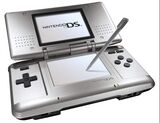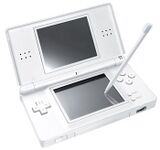Difference between revisions of "Nintendo DS"
From Sega Retro
| Line 32: | Line 32: | ||
}} | }} | ||
}} | }} | ||
| − | The '''Nintendo DS''' (ニンテンドーDS) is a dual screen handheld video game console released by [[Nintendo]] in 2004 as a successor to the [[Game Boy Advance]] line. It was Nintendo's platform of choice for handheld games until the launch of its successor, the [[Nintendo 3DS]] in early 2011. | + | The '''Nintendo DS''' (ニンテンドーDS) (also know as iQue DS in China) is a dual screen handheld video game console released by [[Nintendo]] in 2004 as a successor to the [[Game Boy Advance]] line. It was Nintendo's platform of choice for handheld games until the launch of its successor, the [[Nintendo 3DS]] in early 2011. |
==Overview== | ==Overview== | ||
Revision as of 18:21, 21 July 2015
 
| ||||||||||||||||||||||||||||||||||||||||
| Nintendo DS | ||||||||||||||||||||||||||||||||||||||||
|---|---|---|---|---|---|---|---|---|---|---|---|---|---|---|---|---|---|---|---|---|---|---|---|---|---|---|---|---|---|---|---|---|---|---|---|---|---|---|---|---|
| Manufacturer: Nintendo iQue (China) | ||||||||||||||||||||||||||||||||||||||||
| Variants: Nintendo DS Lite, Nintendo DSi, Nintendo DSi XL (LL) | ||||||||||||||||||||||||||||||||||||||||
|
The Nintendo DS (ニンテンドーDS) (also know as iQue DS in China) is a dual screen handheld video game console released by Nintendo in 2004 as a successor to the Game Boy Advance line. It was Nintendo's platform of choice for handheld games until the launch of its successor, the Nintendo 3DS in early 2011.
Overview
The Nintendo DS is amongst Nintendo's most successful handheld consoles, despite facing competition throughout its lifespan by the PlayStation Portable, and in its latter years, a market increasingly drawn to iOS or Android smartphones and tablets. It is an evolution of the Game Boy Advance design, adding an extra two face buttons and a resistive touch screen, amongst the expected technical improvements. It uses a similar clamshell design to the Game Boy Advance SP (complete with backlit screens), and despite initial scepticism at launch, the system went on to sell over 150 million units worldwide.
Several versions of the DS exist, the most prominent being the Nintendo DS Lite, a cost-reduced unit which launched in 2006 to coincide with an altered marketing strategy (also used by the Wii) to appeal to a wider audience of consumers. An updated DS, the Nintendo DSi launched in 2008, sporting minor upgrades, a camera, and a new line of DSi-specific software. The Nintendo DSi XL (DSi LL in Japan) is similar, but is designed for those with larger hands.
Sega Support
Sega were quick to lend their support to the Nintendo DS from day one, with Feel the Magic: XY/XX being sold as a launch title in the US and PAL regions. Super Monkey Ball: Touch & Roll and Sonic Rush also sold well on the system during its early years.
List of Sega Games for the Nintendo DS
- Sonic series
- Puyo Pop series
- The Rub Rabbits!
- Super Monkey Ball series
- Mystery Dungeon: Shiren the Wanderer
- Sangokushi Taisen DS
- Dramatic Dungeon Sakura Taisen: Kimi Aru ga Tame
- Let's make a series
- Zombie Shiki - Eigo Ryoku Sosei Jutsu: English of the Dead
- Sands of Destruction
- Shining Force Feather
- 7th Dragon
- Phantasy Star Zero
- Infinite Space
Licenced, Miscellaneous, Edutaiment or Kids games
- Mushiking series
- Dinosaur King
- Oshare Majo Love and Berry: DS Collection
- Lilpri DS
- Rekishi Taisen Gettenka Tenkaichi Battle Royale
- Kokoro Scan
- PictoImage DS
- Shiseido Beauty Solution Kaihatsu Center Kanshuu: Project Beauty
- Oshiri Kajiri Mushi no Rhythm Lesson DS
- Black Jack: Hi no Tori Hen
- Bleach series
- Blazer Drive
- Doraemon series
- Suzumiya Haruhi no Chokuretsu
